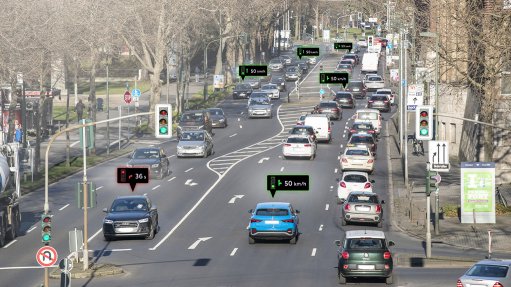
German premium car maker Audi has expanded its networked traffic light project from Ingolstadt to Düsseldorf.
At the end of January, Audi drivers in Düsseldorf will see information from around 150 traffic lights in their cockpit, thus increasing their chance of catching a wave of green traffic lights.
By mid-year most of the intersections in Düsseldorf – around 450 out of a total of some 600 installations – will be networked.
The Audi Traffic Light Information system consists of two functions: Green Light Optimised Speed Advisory (GLOSA) and Time-to-Green.
GLOSA calculates the ideal speed for getting a “green wave”.
GLOSA can also suggest reducing speed at about 250 m from the traffic lights so that the driver and the cars behind his or vehicle can reach the intersection as the lights turn green.
This reduces uneconomical stop-and-go traffic.
If stopping at a red light is unavoidable, a countdown displays the seconds remaining until the next green phase begins – Time-to-Green.
Audi believes this function will allow drivers to relax, take their foot off the accelerator and save fuel.
A number of studies conclude that drivers move through cities more efficiently thanks to networked traffic lights, says Audi.
In a pilot project, Audi was able to reduce fuel consumption by 15%, adds the company.
“With Audi Traffic Light Information we wish to improve convenience for drivers, increase traffic safety and encourage an economical style of driving that looks ahead,” says Audi Apps, Connected Services and Smart City development head Andre Hainzlmaier.
“To do this, [however] we have to predict precisely how traffic lights will behave in the next two minutes. At the same time, exact forecasts are the biggest challenge. Most signals react variably to traffic volume and continuously adapt the intervals at which they switch between red and green.”
Audi and its project partner, Traffic Technology Services, have developed an analytical algorithm that calculates predictions from three sources – traffic signal control programmes; historical data; and then also real-time data from traffic computers, as well as a combination of road-occupation cameras, detector strips in the road surface, data on approaching buses and trams, and pedestrian crossing buttons.
The forecast algorithm improves itself continuously and learns how, for example, the traffic volume changes in morning commuter traffic, or at midday when children leave nurseries and schools.
The Audi fleet itself also plays its part in optimising the traffic light forecasts.
“The cars send anonymised data when traffic lights are crossed to an Audi backend, which checks whether the actual crossings of traffic lights correspond to the forecast data. Only after this are the traffic lights cleared for display in the car,” Hainzlmaier explains.
In future, participating cities will also receive useful information about their traffic light infrastructure.
The data show, for example, whether cars stop unusually often at a particular intersection or whether the average waiting time is comparatively long.
“We aggregate the recorded data into reports that we will make available to city authorities,” says Hainzlmaier. “Traffic lights can then be given more efficient phasing and traffic will flow better.”